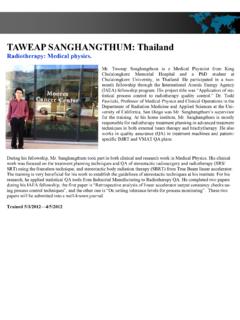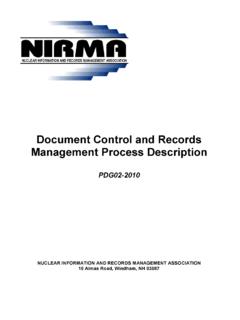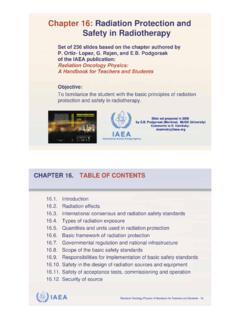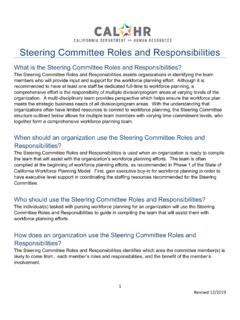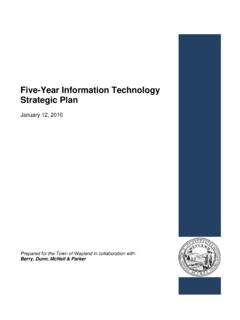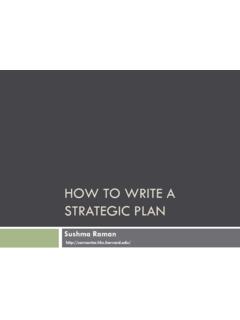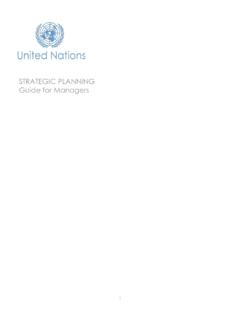Transcription of Optimal Staffing and Scheduling Management
1 A Phase 2 Consulting White PaperNow a part of the Premier healthcare allianceT H E K E Y T O B U D G E T S U C C E S S : Optimal Staffing and Scheduling ManagementOur third White Paper is focused on how to achieve labor and quality targets through the development of a successful Staffing and Scheduling procedure. This topic is a major issue facing many clinical and financial executives today. Clinical Staffing and Scheduling is one of the largest single factors of poor financial, productivity and quality performance. In the last seven years, when ana-lyzing nursing clinical budgets nine out of ten systems are not within 1%-3% of a flex budget. More important-ly, they are experiencing high turnover rates, burnout among care providers and rising sentinel events. The rationale is largely attributed to the nursing shortage. However, when analyzing the proposed Staffing plans and models of care, the hours of care used are gener-ally adequate, but the type of FTE and dollar variances exceed budget norms.
2 This White Paper outlines the Phase 2 Consulting methodology, addresses the trends in patient care, and provides our ten-step process of assuring that clinical satisfaction and finance objectives are achieved through successful implementation. MethodologyPhase 2 Consulting analyzed the Staffing and schedul-ing data of ten former clients. We evaluated their stated Staffing plans and their congruency with budgets. We also assessed the clinical and financial results and over-all satisfaction of the strategies used. In order to ensure all relevant data was incorporated within our analyses of Staffing , Scheduling and budget, we also gathered the following data: Proposed versus actual Staffing Position control budget versus actual, including full time, part time, per-diem/pool hours and agency hours by category (RN, LPN, Nursing Assistants, etc.) Salaries and shift differential, by class Overtime percentage, by class (full time, part time and per-diem employees) Extra incentive bonuses above and beyond regular hours, by class Agency usage budget, by class, versus actual budget Turnover rates, by unit and class Vacancy rate trends, by unit and class Master Scheduling patterns and holes, by unit Volume/utilization predictions, by day of the week and shift Nursing plans of care Outcomes (clinical, quality and financial) Phase 2 Consulting initially obtained and used this raw data to achieve the improved financial and clinical out-comes now experienced by these ten healthcare in Patient Care ServicesIn Phase 2 Consulting s initial assessment of the ten healthcare systems, we discovered five adverse trending patterns affecting patient care services today:1.
3 Missed Budgets: CFO complaints are on the rise regarding patient care services continuously missing budgets. When analyzing nursing clinical budgets, we found that nine out of ten systems are not with-in 1%-3% variance of their flex Rising Turnover Rates: Our clients average turn-over rate was increasing from 15% to 17-20%. One of the principal reasons for this increase is the rise in unwelcome overtime, which leads to burnout among care Medicare Length of Stay is Increasing Again: Many of our clients average .5-1 day above the Medicare average. Less than Optimal Staffing reduces the ability to move patients through the system in a timely Cost Shifting: Although there appears to be a reduction in agency costs, dollars paid in premiums (double OT bonuses) and orientation costs are increasing. 1 THE KEY TO BUDGET SUCCESS: Optimal Staffing AND Scheduling MANAGEMENT5.
4 Chronic Recruitment and Retention Issues: The issue of supply and demand has always been cyclical in clinical services, however, the recovery period appears to be getting longer. A good Staffing and Scheduling plan can and will alter these trends and allow appropriate Staffing to improve financial and clinical performance. Phase 2 Consulting has identified three common themes contributing to the adverse patient care Staffing and budget trends. Lack of patient care strategic planning Incomplete budget methodology Chronic crisis Staffing and Scheduling managementTEN Steps to Successful Staffing and Scheduling OutcomesPhase 2 Consulting recommends the following action items to help organizations optimize Staffing and budget Time for PlanningMost organizations approach the budget process with little planning. Having a sound plan can help to reduce last minute changes, a common cause for budget failure.
5 Review the Master Patient Care plan Annually The Nursing plan of Care is a document required by JCAHO (Table 1). This document is unique to each organization and specifies by unit the type of patient population, care delivery and Staffing mix that your organization is committed to delivering. The Nursing plan of Care should be a roadmap for patient placement and daily Staffing , yet it often goes often, the Nursing plan of Care is not utilized when building daily Staffing grids or the patient care budgets. This synergy is critical in assuring that patients are cared for properly, unexpected co-morbidities are avoided, and budgeted targets are achieved. We recommend the Nursing plan of Care be re-evaluated annually and analyzed against clinical, financial and satisfaction performance before budgeting begins, and then re-evaluated after the budget process is over to assure internal consistency and successful a Unit-Specific Staffing PlanThe next step is to develop a Staffing grid based on the Staffing model.
6 The Staffing model of care should be based upon three components: 1) nursing plan of care for each specified unit: 2) the projected utilization or ADC (average daily census): 3) the benchmark or target HPPD (hours per patient day). These three components must be analyzed and modified annually. After the model of care has been agreed upon, historical patient day utilization can be trended over three years. The new ADC is projected from historical averages and future strategic expectations. Once the ADC is determined, each unit manager should input the data into the Staffing grids based on the plan of care. The target productive HPPD is then determined from this input data. The manager will average the HPPD target at the budgeted ADC as well as 2 above and 2 below the target (see the highlighted area in Table 2), which will permit an accurate projection of the HPPD. Having this target average established allows budget accuracy when the daily census fluctuates.
7 The final ADC, HPPD target, and Staffing mix should then be reviewed with the finance department before moving to the next step. The Staffing grid information should be utilized to create additional information that will role-out the final budget. Staffing grids drive the final required FTE position count, the position control, and the labor dollar numbers. Accurate projections of FTEs and labor expenses make it simple for managers to complete a budget process and also assure internal consistency. The Staffing grid (Table 2) should then be used as a guide for the frontline Management to control the budgets of every 1: EXAMPLE plan OF CARE 1001 Specialty Unit Unit 1001 is a 12-bed post-cardiovascular surgery telemetry unit. Patients admitted include pre- and post-cardiac surgery patients and other chest surgeries. This unit also can be used as an overflow for other surgical patients.
8 The nurse-to-patient ratio in this unit is 1 RN to every 2-3 patients. The capacity for this unit is 12 beds, while the average daily census is nine beds a current occupancy rate of 75%.Create a True Flex Budget MethodologySeven out of the ten hospitals studied lacked a clearly defined patient care budget methodology. Three frequent mistakes include the lack of budgeting premium dollars, mismanagement of agency dollars, and failure to reconcile the budget with the planning tools. One, or all, of these mistakes are often the cause of budget overages. Determine the FTE Demands by Skill Mix TypeOnce the Staffing grid is developed, the next step becomes easier because the skill mix worksheet is linked with information on the Staffing grid. (Table 3). Each manager is required to verify the data on the worksheet in order to calculate the non-productive (or replacement) time and to ensure the proper FTE complement (full-time (FT), part-time (PT) and prn or agency staff) is budgeted and agreed upon.
9 First, the manager must confirm that the correct data is used to build the Staffing grid. This data needs to include the ADC, HPPD, and the number of staff required 24 hours a day and 365 days a year. A correct Staffing grid will identify the proper number of productive FTEs. Next, the non-productive time, as a percent of the total productive time, must be calculated and compared to the targeted non-productive percentage. The percentage is best determined when vacation, sick, education, and FMLA is assessed for historical utilization and then projected by employee. Finally, the percentage breakdown of FT, PT, and per-diem employees should be determined by the variation in census patterns for the specified unit. In general, if census patterns are found to not fluctuate greatly, most clinical units require an 80% FT, 10% PT and 10% per-diem structure in order to create a true flex budget and keep overtime within benchmark levels (1-3%).
10 Although many healthcare systems believe they are using a flex budget system, this FTE complement is often overlooked, despite its critical nature to the success of an actual flex definition, a true flex budget system establishes a schedule in which unnecessary staff are called off without pay during low census days. To create this type of schedule, nearly every shift, or at least shifts with unpredictable census fluctuations, must be assigned a per-diem staff member. An external per-diem company should be considered if the internal per-diem pool is unable to fill these Staffing requirements. Per-diem Staffing should be used to fill these three conditions: 1) daily Staffing requirements as per the grid: 2) replacement or non-productive positions: 3) census peak above 15-20%. Hospital and system administrators need to ask themselves, does our FTE mix employ enough per-diem staff to fill all of the previous three conditions?

